Tenra Bansho Zero by ProfessorProf
A Thing About The Game
Original SA post
Once upon a time, a guy named Junichi Inoue sat down, took a long, hard look at all of the world's anime, and decided that it just wasn't anime enough for him. This was the result.
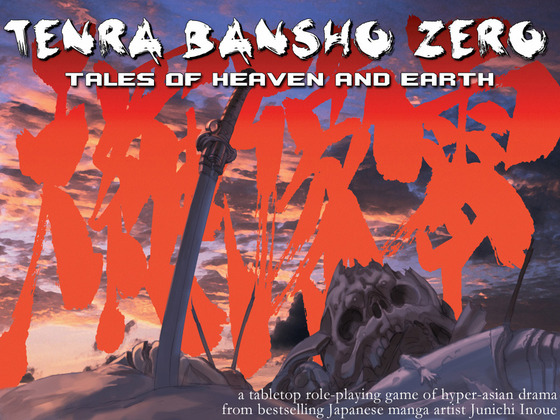
I don't know if that's the actual backstory behind its creation, but
Tenra Bansho Zero
is a kabuki-inspired high-drama action storygame taking place in the most ridiculous and ridculously Japanese fantasy world imaginable. About two years ago, an English version was successfully kickstarted. While I have my beefs with the system when it comes to actual play, it has a lot of very interesting ideas and a batshit insane setting that should make a readthrough plenty interesting.
Contained in this game, among other things:
-
Central game mechanics revolving around trying not to lose your mind and become a rampaging hate monster!
-
Giant mecha powered by demon hearts being cut in half by swords powered by fossilized souls!
-
The ability to play as a transforming robot dog that is also a ninja!
-
Android bodies being possessed by amnesiac demons!
-
Centipedes as a fully-developed branch of magic!
There are two books, one outlining the rules and one outlining the setting fluff. I will be bouncing back and forth between the two at random.
Tenra, the Great Land
Original SA post
Then let's not waste any time!

Tenra Bansho Zero, Worldbook 1: Tenra, the Great Land
The Worldbook opens up with a high-level overview of the game's world, Tenra. Fairly homogenous in climate and people - no Frozen North, everyone speaks the same language. Five main regions, laid out as such:
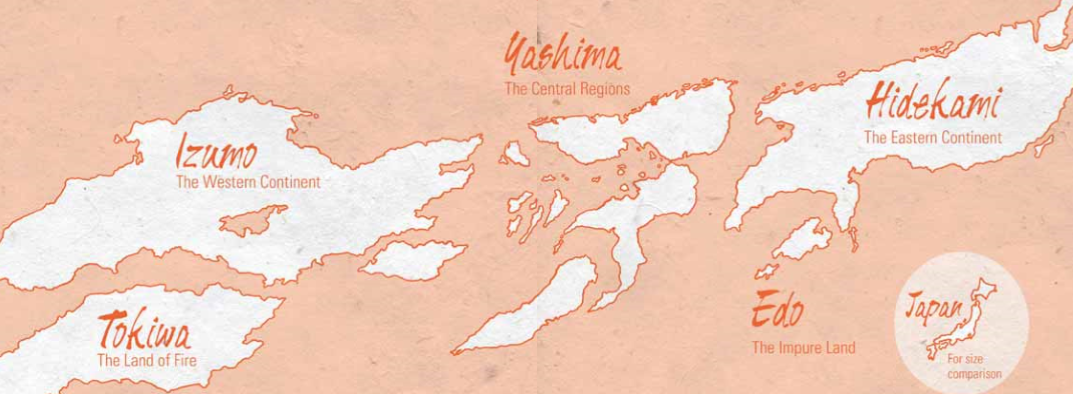
From west to east:
-
Tokiwa
, the southern continent, is known for its annual massive thunderstorms and for the mysterious artifacts that regularly wash up on its shores.
-
Izumo
, the western continent, is known mostly for being ass-deep in fucking monsters, and also for being the site of the famous battle between Yamata-no-Orochi and Susano-O. This version went a little differently from standard mythology; traditional depictions of Yamata-no-Orochi have eight heads instead of nine, and traditional depictions of Susano-O do not have him being a giant killer robot.
-
Hidekami
, the eastern continent, is primarily known for being covered in mountains and dense forests and generally a huge pain in the ass to navigate.
-
Yashima
, the central continent, is the cradle of civilization and the political and social heart of Tenra.
-
Edo
, the impure land, is a formal penal colony where all evils of the world gather, and total insane anarchy reigns supreme.
Stop! Zoom in! Enhance!
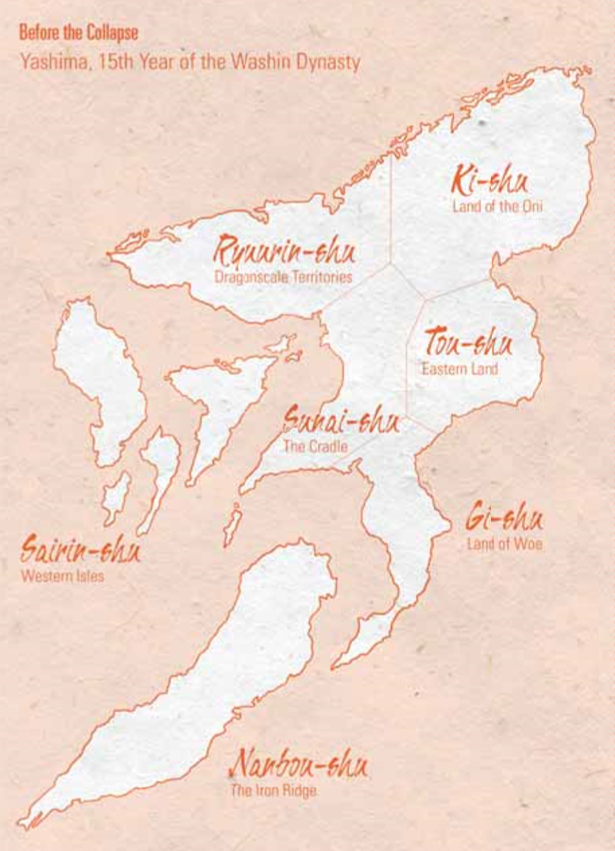
Yashima is the main hotspot of political action, so let's take a close look! This is what Yashima used to look like. Notice how it's a lot less In Pieces than it is now.
Region rundown:
-
Ki-shu
is the land of the Oni, and is accordingly where the most Armours (mecha) are made, on account of Armours are powered by Oni hearts. I'm sure you can imagine how the Oni feel about this.
-
Ryuurin-shu
is the Dragonscale Territories, so named for the totally kickass mountain range that dominates it.
-
Sairin-shu
is a series of islands, each one a separate country. Due to the water barrier, this is one of the few regions that isn't full of states that are in a perpetual state of war with their neighbors.
-
Nanbou-shu
is another mountain-divided region known as the Iron Ridge, and is busy making up for the relaive peace of Sairin by murdering each other even harder.
-
Sunai-shu
is the seat of power of the Shinto Priesthood, and also the politcal skulduggery capital of Tenra.
-
Gi-shu
, the Land of Woe, is an area that is perpetually even more politically unstable than the rest of Tenra.
-
Tou-shu
is isolated from its neighbors by mountains, but still manages to be perpetually at war within its borders.
Now, that was way long ago. These days, due to an event called the Fall of the Phantom Star, it looks more like this:
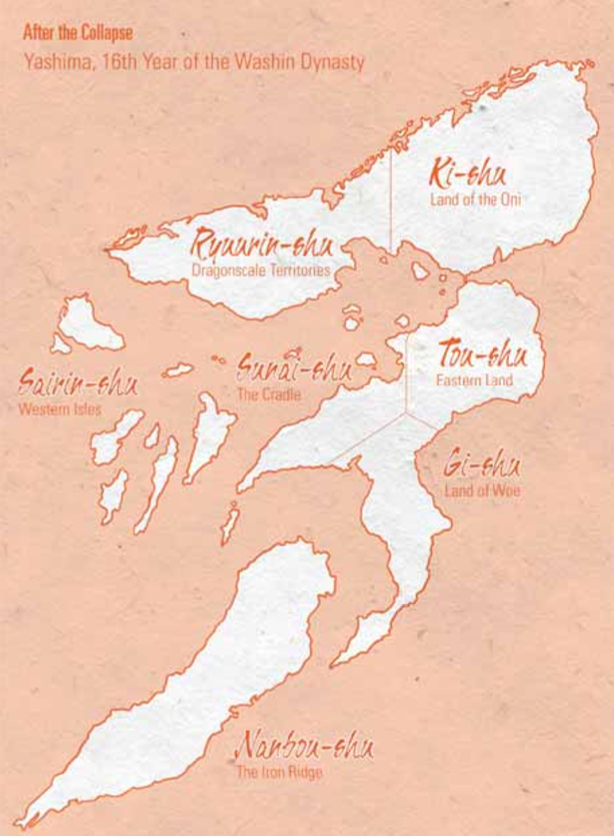
Looks a little different! The Cradle was totally annihilated as most of it sank into the ocean. The remains of the Cradle are the seat of power of the Priesthood's Southern Court, and the Dragonscale Territories are the seat of the Northern Court, with the islands in between being constantly contested between them. The Oni are in charge of Ki-shu now, and Tou-shu has been taken over by Buddhists.
So that's a high-level overview of the least insane parts of the world of Tenra. In a fairly odd move, the section ends with this:
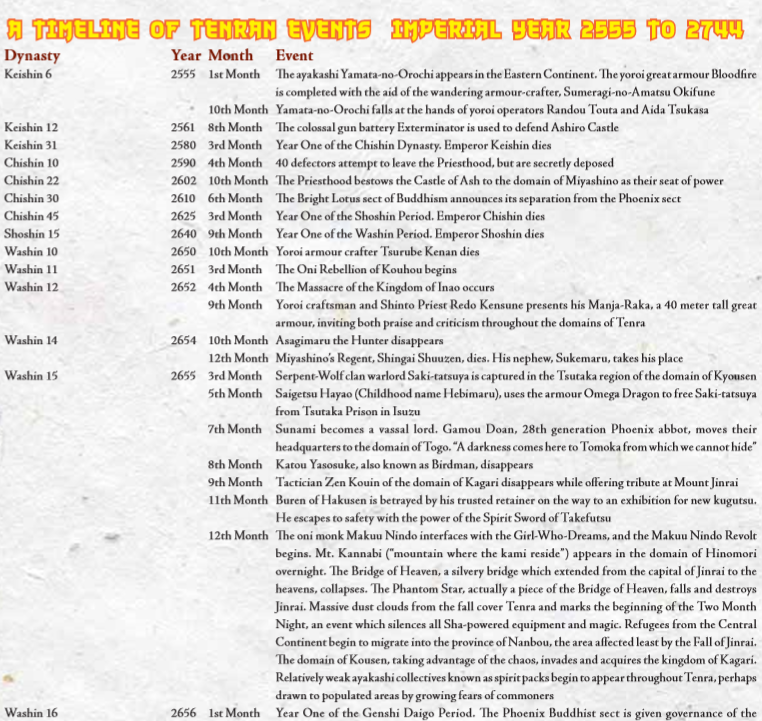
It goes on for three pages, just dates and events with no context. At first, this seems totally insane and pointless, but according to a note at the end, these are intentionally vague because they're here as adventure hooks. An interesting idea, at least.
NEXT TIME: The first bit of the actual rulebook!
Introduction
Original SA post
Rulebook 1: Introduction
Like every RPG rulebook over 100 pages, TBZ opens with a brief section explaining what, exactly, RPGs are, nothing too special there. After getting past the basics, we get a high-level overview of the things that set this game apart from its brethren!
-
The Emotion Matrix! Randomly determine first impressions when two characters meet for the first time. This sounds bizarre at first, and will continue to sound bizarre, but it's actually one of my favorite aspects of the system.
-
Aiki chits! The book tries to make them sound like a completely original idea, but they're not.
-
The Karma system! Accumulate Karma as you grow in power, and try not to go insane with the burden of worldly attachments!
Those are the big points. The rest is pretty straightforward, nothing surprising to the seasoned player. On to the real introduction!
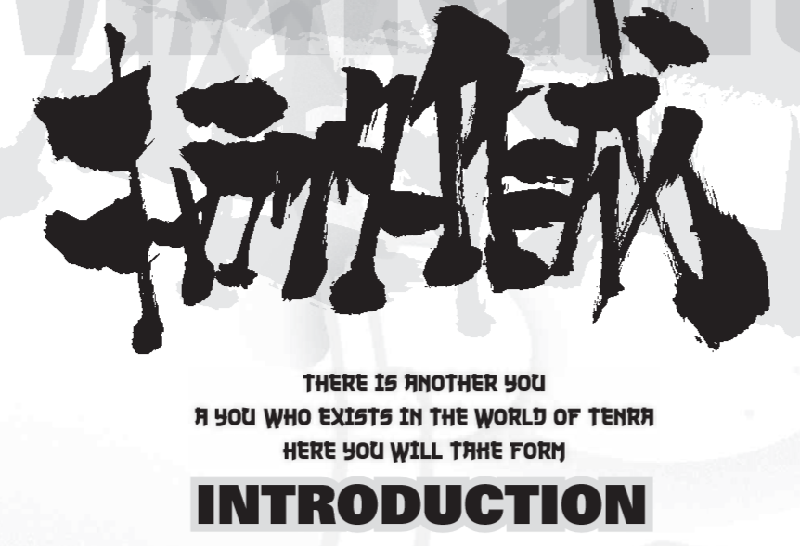
The stuff up ther was the "Welcome" chapter, so sort of the pre-introduction. This is the introduction proper, which dives straight into chargen!
TBZ character creation is a bit clunky, and I get the feeling reading the book that it's aware of this. The first suggested method of chargen is using premade characters from the back of the book. It talks about being conscious of the kind of scenario the GM is planning to run (if they've made any plans) and doing chargen as a group, but at the same time, this isn't a system where you need a balanced set of character roles in the party. Wanna do a ninja game? Everyone's a ninja, no problem. Doesn't really cause any problems.
Of course, we're all pros here, so we're gonna want to make a character from scratch. Taking it step by step:
1. Archetypes
In the place of a class system, there are Archetypes, ranging from specific (Priesthood Double Agent, Ninja Apprentice) to the general (Thief, Aristocrat). You can mix and match Archetypes freely (Ninja Apprentice from a noble background, who is also a thief, and a double agent for the priesthood), provided you can afford all of them.
Like all aspects of character creation, Archetypes give you Karma. Each Archetype has a Karma Cost, and when you finalize your list of Archetypes, your Karma is set to the sum of their costs. At no point during chargen can you exceed 108 Karma, and even being too close to that to start is dangerous. About 70 to 90 Karma is typical to start with. More about that later.
Each Archetype, in addition to a Karma cost, has a set of skills, equipment, attribute requirements, possible Fates, and all sorts of other fun stuff I'll talk about more as I go.
2. Attributes
Basic D&D-style stats. The list is Body, Agility, Senses, Knowledge, Spirit, Empathy, and Station. Most of those are fairly obvious, but Station s your social status and influence, and Empathy is about what it sounds like but has a very important usage I'll get to in the Karma System. Low Empathy characters are seldom viable.
Between these seven attributes, distribute 40 points. Max 10, min 1, recommended to not go below 3 for anything. Some Archetypes have minimum attributes (you can't have an Aristocrat with a Station below 2) and some also have Attribute penalties - if you have two Archetypes with Attribute Penalties of 1, then you only get 38 points. Pretty simple.
Most mundane humans have attibutes in the 1-3 range. PCs are special.
3. Sub-Attrbutes
Calculated stats. Three of these:
-
Vitality
: Body + Spirit. Ability to not die. If these reach 0, you are out of the fight, but do not die.
-
Soul
: (Knowledge + Spirit)x2. Mana. Magical abilities drain this, and if it reaches 0, you lose consciousness.
-
Wounds
: Something kind of like the stress track in Fate, you have various tracks of boxes representing different severities of injuries. More on these later, but you have Light wounds equal to your body, half that many Heavy wounds, half
that
many Critical wounds, and one Dead box.
4. Equipment
Some equipment is provided automatically by your Archetype, and the rest you can get for yourself. However, many items (more advanced weapons) have a minimum Station requirement, and many also raise your Karma. Money exists in the setting, but there aren't really any rules for it. If it makes sense for you to have a certain amount of money, you do, and if it doesn't, you don't. Wing it.
5. Fates
Fates are the emotional core of your character, and very integral to the Karma economy in ways that, once again, I'll get into later. They can be destinies, emotions, or goals.
Archetypes have associated Fates. From the list of Fates from all your Archetypes, pick two, one rated at 2 and one at 3. Honestly, though, if you've got a character concept in mind, just make up Fates. Just go crazy.
6. Special Abilities
Then, the fun stuff. Which of these you get is based on your Archetypes. Some fun ones:
-
Meikyo Soul Mirror
: A device used by agents of the Priesthood and some kinds of armour riders that can be used to interact with The Reflection, which is a magical Shinto internet. It's also used to interface with an Armour and to communicate at long range with your fellow Shinto Illuminati agents. This interacts with Karma in strange ways.
-
Kongohki Overdrive
: Oh hey, we don't know what Kongohki are yet, do we? This chapter is full of mystery terms. It doesn't even try to define this one here, aside from saying that Kongohki can boost their attributes temporarily.
-
Annelid Implantation
: Annelidists are people who implant monster worms into their body and then control them to do all sorts of freaky shit. This costs Karma.
-
Oni Resonance
: Oni get magic powers. More on this later.
-
Samurai Ability
: Samurai have magic gems implanted into their body, and can use them to transform into a pseudo-monstrous alternate shit-wrecker form.
-
Shinobi Arts
: Implanting gems into your body that make Ninja magic easier. Can't do this if you're a Samurai.
-
Kijin Modification
: Cyborg parts. Get a hand that turns into a gun. Usually comes with an Attriute cost.
-
Kugutsu Butterfly Dream
: Illusion magic, only available to artificial humans called kugutsu. Hypnotize someone and draw them into the dream world.
-
Yohjutsu
: Abilities used by Ayakashi or half-Ayakashi. Monster people. Karma cost for them can be reduced by taking Weaknesses.
So that didn't make much sense, but clearly we're in for a wild ride here. Chargen's layout is kind of a mess, isn't it? Next time, back to the Worldbook.
Sacred and Inviolate, the Priesthood is Impenetrable
Original SA post
Worldbook 2: Sacred and Inviolate, the Priesthood is Impenetrable
Shinto is the indigenous religion of Japan, being casually practiced by 80% of the population. It teaches ways to cleanse ritual impurity for the sake of one's own spiritual and mental well-being, and-- oh wait, I confused Earth with Tenra. Let's start over.
Shinto is an all-encompassing god-empire that controls all aspects of Tenra politics. The only thing more impossible than knowing the Shinto Priesthood's machinations is defying them. Shinto technology, such as the Meikyo soul mirror, is given to Tenra's official rulers and regents, then used as collateral to control them.
Now, things have changed, and the Fall of the Phantom Star hit right at the heart of the Priesthood's power, and they have since fractured into two courts.
The Northern Court
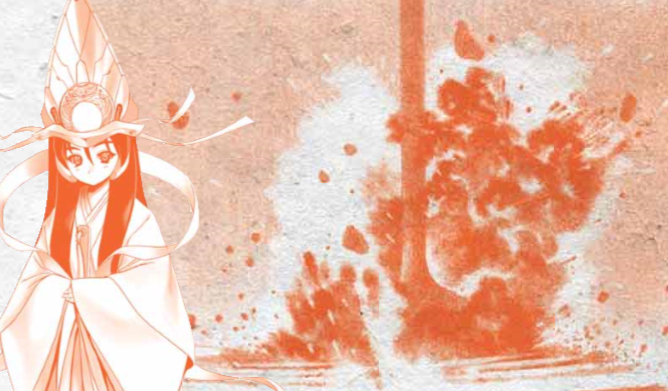
Depicted: Empress Genshi Daigo, age 14 (of course), and the fall of the Phantom Star.
When the Phantom Star fell, there was a two month period where nobody saw the sun and everything was terrible, aside from the slight perk that everyone thought the Priesthood had been wiped out. Unfortunately for them, immediately after the Two Month Night ended, the Northern Court appeared with a floating island capital called Genshikyo, and proclaimed their return with the announcement of the first ever publically-visible Priesthood Empress, Genshi Daigo. Genshi (who may or may not have been an artificial human built by the Priesthood) declared this to be the beginning of a new era of "open" Shinto, with all of the secrecy and cloak-and-dagger of the old Priesthood to be over. This started with the reveal of the secrets of construction behind Meikyo soul mirrors.
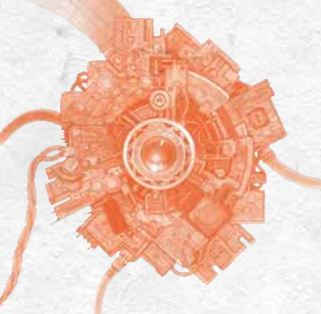
Non-Priesthood Soul Mirrors are so shitty that they look like something made out of actual technology.
Despite their open policy, apparently the Priesthood didn't reveal all the secrets of Meikyo, because there remained an enormous gulf in quality between their soul mirrors and those made outside of the Priesthood. The massively inferior shitty knockoff mirrors are called Kimenkyo , and while they're not the flawless works of art that the Priesthood produces, they can be mass-produced, and can still be used to produce Armours, so while the Priesthood still has unknowable secret technology on their side, the common folk can at least have massive armies of giant robots.
Priesthood technology secrets are obviously in huge demand, and here's the other thing - just because the capital has been turned into an ocean by a natural disaster doesn't mean that everything there was destroyed. The result of this was the establishment of a number of salvaging operations along the coasts of that sea, with specialized underwater Armours being sent to the bottom of the ocean to dig up artifacts from the ruins of Jinrai.
The Southern Court
While the Northern Court is doing everything in their own new and interesting style, the Southern Court is being as traditional and reactionary as ever. They considered Genshi to be a vile traitor and pretender to the throne, and viciously outlaw the production of Meikyo technology and hide their secrets as much as possible. Ruling from their stronghold on New Mount Jinrai, the Southern Court considers themselves the only true Priesthood. The Northern Court controls the northern half of Yashima and the Eastern Continent, while the Southern Court controls the south half of Yashima and the Western Continent.
Shrine Maidens and Priests
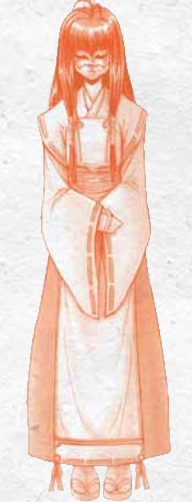
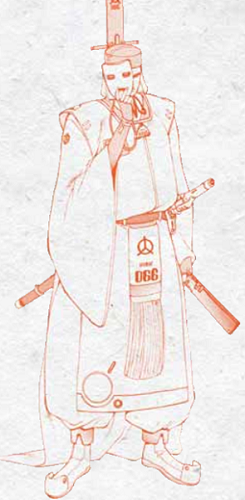
The agents of the Priesthoods are organized into an elaborate hierarchy, from the Emperor down to common Priests and Shrine Maidens recruited from the general populace. High-ranking members rarely leave the Priesthood capitals, and (with the exception of Genshi) are forbidden to show their faces in public. High-ranking Agents always wear face-concealing masks and generally try to be as cool and mysterious as possible.
Low-ranked agents are recruited from outside the insular society of the Priesthood, and are the main way for the Priesthood to interact with the world at large. These agents are Taira , the lowest rank of the Priesthood, and are called onshi if male and miko if female. Onshi visit regions without shrines to provide protective amulets and rituals, and miko maintain shrines and use Meikyo mirrors, some of them piloting great Armours on the side. Both have the authority to freely travel across Tenra, and both wear smaller masks only covering the eyes, and can show their faces under certain circumstances.
Transcendent Technology
Humans are known to not be native to Tenra - we came to this world from somewhere else (there are various hints that this used to be a full spacefaring sci-fi setting, but this particular world lost all contact with the greater human race and the technology with which to reach them - that's my take on it, anyway). According to the Priesthood, they came from afar to discover this land, and non-Priesthood humans are its native inhabitants. However, there's another bit of lore that contradicts this: The oni say that all humans are outsiders to their land, and the Priesthood took control at some point, taking all the higher technology for themselves.
Most currently-used Priesthood tech is based on Onmyoudo (taoist magic) and Sha (power inherent to the land of Tenra), but they still have some remnants of a much older power, transcendent technology from before humans ever came to Tenra. The most famous example of this was the old capital, built around a bridge connecting Tenra to the heavens themselves (orbital elevator), but they have plenty of other great ancient artifacts. Massive flying battleships, living machines, Shinto magic that calls down stars and lightning from the heavens to annihilate their foes.
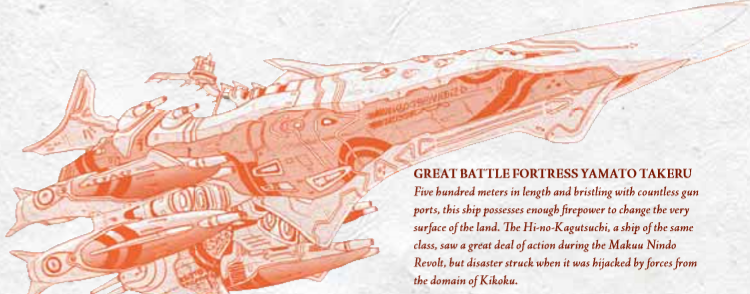
In the days before the Phantom Star, the Priesthood easily had enough power to rule and unify all of Tenra. However, they never did so, instead spreading chaos and blodshed from the shadows. Their true purposes remain a mystery, but much of their control over Tenra was lost when they split into the two courts. Much development in the modern world happens outside of the Priesthood, with Buren, leader of the powerful domain of Hakusen, having openly declared war on them. The balance of power is shifting in Tenra, and the Priesthood is not getting the best out of it.
NEXT: Actual action resolution rules!
Basic Actions
Original SA post
Rulebook 2: Basic Actions
So! Actually playing Tenra Bansho Zero.
Doing something in TBZ pretty much always means you roll a combination of a Skill and an Attribute. Most Skills have a default Attribute they use, but any Skill can be used with any Attribute depending on the circumstances. If you want to put an arrow through someone's skull, that's Marksman and Senses, but if you want to pull an arrow out of a corpse and try to identify where the arrow was made, that's Marksman and Knowledge.
TBZ is a dice pool system, but the interesting thing is that what constitutes a success on a die is variable. When rolling, your Attribute is the size of your dice pool, and your Skill is the target number to roll under. So, in the second above example, if you had a Knowledge of 7 and a Marksman of 4, then you'd roll 7 (six-sided) dice, and every result of 4 or lower would count as a success. The number of required successes to do something varies from 1 (easy) to 6 (almost impossible).
Here that explanation is as a one-page comic!
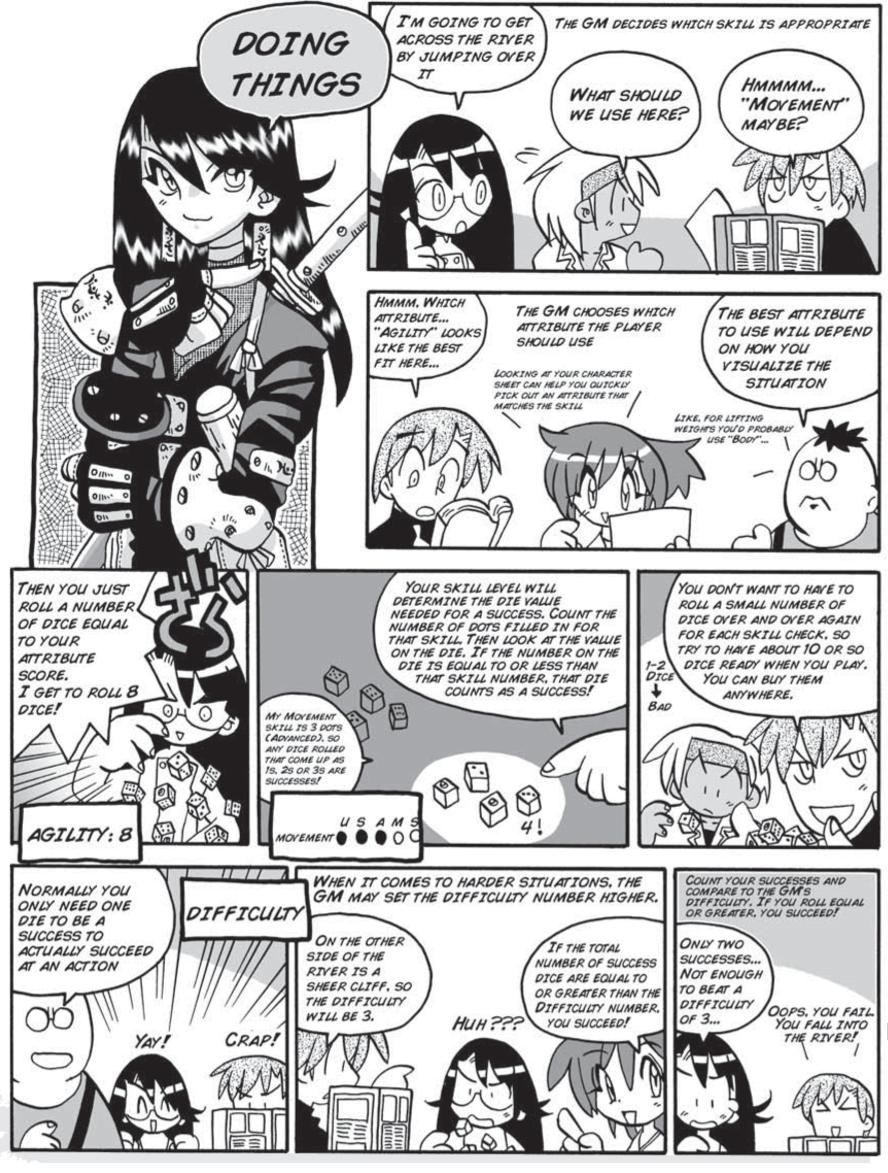
Opposed rolls are pretty simple - just both roll, and compare successes. In some circumstances (attack rolls), ties have special meanings, but normally you just keep rerolling until someone wins. Have another one-page comic!
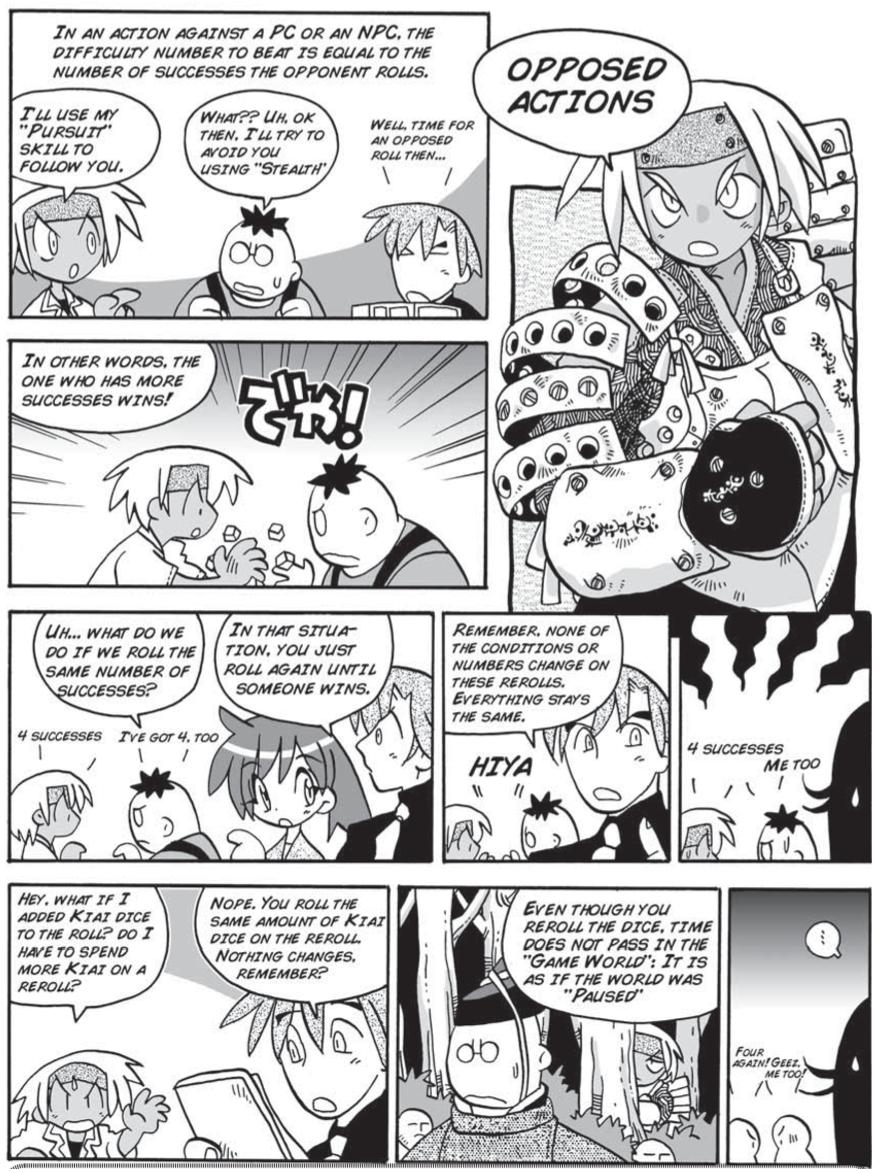
Money & Stuff
TBZ doesn't track money. Explicit amounts of money are just window dressing for a scene or conversation. In practice, this works out to be something lke the wealth system from D20 Modern - your Station attribute becomes a representation of whether or not you can afford things.
Equipment can break, but there's no durability system. The only times when an item will break are if it's part of a planned plot thread, or if it's established by the GM in advance of a roll as a possible result of failure. If something breaks, it can't be used until you have a chance to sit down and get it repaired.
Sometimes you get special equipment during the course of a adventure, and using it doesn't cost you anything. However, if you want to keep it past the end of the current act, you'll need to spend Kiai (more on that later) the same as getting it during character creation.
Skills
Skills come in two categories: General and Specialist. If you try to roll a General Skill despite not having it on your character sheet, you roll it at skill rank 1. If you try to roll a Sepcialist skill but don't have it, you automatically fail. Skill ranks vary from 2 to 5, but rank 5 is only available with special scenario-related circumstances, and some skills may require a certain background (i.e. being a Noble).
So, here's a list of every skill and how to use it with most Attributes.
Unarmed Combat : Punching guys in the brain. Default Body.
Body: Attacking and Defending.
Senses: Sizing up an enemy to figure out how badass they are.
Knowledge: Recognizing a combat school in action.
Spirit: Detecting killing intent.
Station: "Demonstrate your martial ability through words or actions," whatever that means.
Wormcharm : Manipulating magical worms (Annelids) implanted in your body. Specialist, default Body.
Body: Melee attacks with annelids.
Agility: Catching wild annelids.
Senses: Finding annelids, annelid ranged attacks (shooting bees at people).
Knowledge: Knowing shit about annelids.
Empathy: Caring for annelids.
Station: Knowledge about mushi-tsukai, nests and rank in annelid-user society.
Movement : Moving your body. Default Agility.
Body: Hard endurance run, lifting heavy things.
Agility: Sprinting, falling gracefully.
Station: Riding a horse.
Melee Weapons : Fighting people with swords, spears, axes, whatever's handy. Default Agility.
Agility: Attack and defense with weapons.
Senses: Determining the relative power or skill of a foe.
Knowledge: Weapon esoterica.
Spirit: Detecting killing intent.
Station: Intimidation.
Evasion : Getting out of the way of attacks. Can be used against any kind of attack, but counterattack is not possible. Default Agility.
Agility: Dodging an attack.
Spirit: Detecting the hidden presence of others.
Station: "Demonstrating your power," sometimes the Station uses are super vague.
Stealth : How not to be seen. Default Agility.
Agility: Move silently.
Senses: Detect an ambush.
Spirit: Mask your presence.
Ninjutsu : Ninja magic. Specialist, default Agility. More on that in a future chapter.
Criminal Arts : Picking pockets, picking locks, traps, poisons. Being good at crimes. Specialist, default Agility.
Agility: Pickpocketing, sleight of hand, disabling traps or locks.
Senses: Spotting traps, detecting poisons.
Knowledge: Criminal knowledge, poison lore.
Spirit: Intimidation.
Empathy: Underworld connections.
Station: Social status-based intimidation.
First Aid : Helping people not die. Default Senses.
Senses: Performing first aid, finding medicnal plants.
Knowledge: Herbal lore, doctoral knowledge.
Notice : Spot things. Default Senses.
Senses: The obvious use.
Spirit: Detecting hidden presence.
Marksman : Shoot things and/or people. Default Senses.
Senses: Shooting or throwing something at someone.
Knowledge: Ranged weaponry lore.
Spirit: Detecting an impending ambush.
Station: Intimidation.
Pursuit : Hunting people for fun and/or profit. Default Senses.
Senses: Spotting clues, tracking down prey.
Knowledge: Knowing common runaway/refugee hideouts.
Spirit: Covering your tracks, blending into a crowd. The Assassin's Creed thing.
Forgery : Make convincing fake documents. Specialist, default senses.
Agility: Creating a forgery by hand.
Senses: Engineering and setting traps (For some reason), spotting forgeries.
Knowledge: Forgery lore.
Empathy: Connections in forging circles.
Station: Connections with fences and people who move stolen or forged goods.
Informaton : Knowing a lot of stuff. Default Knowledge.
Knowledge: Knowing things due to personal research.
Station: Knowing things through court connections.
Onmyoujutsu : Taoist summoning magic. Specialist, default Knowledge, more on that later.
Art of War : Knowledge in one of several unique and powerful martial arts. Specialist, default Knowledge, more on that later.
Willpower : Mental and spiritual fortitude. Default Spirit.
Body: Resist torture, endure physical stress.
Senses: Size up a person.
Knowledge: Avoid a con.
Spirit: Resist intimidation or temptation.
Empathy: Resist temptation.
Station: Resist intimidation or temptation by virtue of your status (???).
Resonance : Call upon the power inherent in the earth to perform magical feats. Specialist, default Spirit, oni only.
BODY: Use Dii. More on that later.
Spirit: Use or resist Resonance.
Empathy: Use Alu. More on that later.
Station: Standing in oni shaman circles.
Interface : Use of a Meikyo mirror. Specialist, default Spirit, Priesthood only, more on that later.
Buddhist Magic : Exactly what it says. Specialist, default Spirit, more on that later.
Persuasion : Use dialogue to get what you want. Default Empathy.
Body: Physical blustering.
Agility: Fast-talk, quickly explaining something away.
Senses: Starting rumors.
Knowledge: Discourse, theorizing.
Spirit: Stopping someone in their tracks with a powerful command.
Empathy: Flattery.
Station: Starting or using court rumors.
Pillow Arts : I guess it's not a full RPG book without a seduction skill. Default Empathy.
Senses: Spotting when someone is interested in you.
Knowledge: Knowing who is seeing who.
Spirit: Resisting seduction.
Empathy: Seduction.
Station: Using your political status as weight to seduce someone.
Perform : Music, dance, theater. Specialist, default Empathy.
Body: Dance, taiko drumming.
Agility: Tradtiional dances, biwa, shamisen.
Senses: Acting.
Knowledge: Artistic lore.
Empathy: Singing.
Station: Influence in performance circles.
Etiquette : Knowing how to handle yourself in a high-status situation. Specialist, default Station.
Agility: Ceremonial dance.
Senses: Polite entertainment, caligraphy.
Knowledge: Poetry, tea, tea ceremony.
Empathy: Conversing with nobility, social maneuvering.
Station: Saying and doing the right things.
Shinto : Special skill representing standing within the Priesthood. Specialist, Priesthood only, more on this later.
Art of Rule : Training in how to out-maneuver people in politics and war. Specialist, default Station.
Knowledge: Negotiation, political history.
Empathy: Charisma and leadership.
Station: Court politics, diplomacy.
Strategy : Anticipating and overturning enemy schemes, be it in war or politics. Specialist, default Station.
Knowledge: Knowing the size of an enemy army, military history.
Empathy: Anticipating an enemy's next step.
Station: Crafting strategies, war council machinations.
NEXT: Domains and Regents.
Domains and Regents
Original SA post
Worldbook 3: Domains and Regents
Fair warning: A side box near the start of this chapter cautions that this is a huge amount of more or less unnecesary information about Tenra government and politics. Like hell if that's going to stop me from covering it, though.
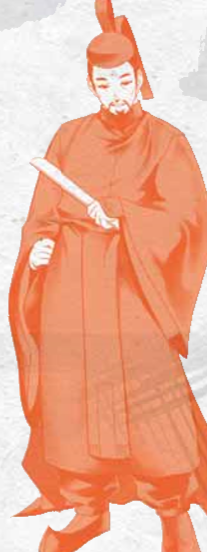
A domain is the largest cohesive unit of territory in Tenra, containing multiple clans ruled by a single regent. True regents are those rulers acknowledged formally by the Priesthood, and are granted the title of Tsukasa, which becomes part of their name. If Shimeki Masataka becomes the formal regent of Iiba, then his name becomes Shinmeki Iiba-no-Tsukasa Masataka.
Except that there are two Priesthoods, both of them considering the other to be illegitimate, so no matter who you are, somebody doesn't recognize your rule.
Anyway, a domain is divided into fiefdoms, each of which is ruled by a vassal lord. You become a vassal lord by impressing your regent with your loyalty and prowess enough that he grants you some land and a title (same naming scheme as a regent, but Kami instead of Tsukasa). Vassal lords can have a great deal of power, but their position is precarious, with their underlings constantly plotting to overthrow them and claim their territory.
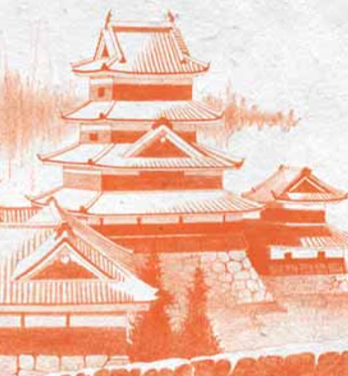
Regents and vassal lords are both served by legions of retainers, who serve their masters in exchange for favors of money, treasure or land. There are a number of official types of retainers:
-
Senior Elders (Shukurou/Karou): Experienced advisors and top administrative officials.
-
Lesser Elders (Chuurou/Wakarou): Experienced aides who aren't quite as awesome as the senior elders.
-
Scribes (Yuuhitsu): Secretaries and record-takers directly serving lords.
-
Ministers (Bugyou): Subordinates in charge of specific spheres of influence - temples and shrines, accounting, specific cities.
-
Watchers (Metsuke): Informants who keep an eye out for corruption or treason.
-
Minor Officials (Shoyaku): Chumps who probably think they have more power than they actually do.
-
Regional Authorities (Gundai/Daikan): Officials in charge of large swaths of rural territory.
Retainers who lose their positions, either due to espionage or the loss of their domain, often become ronin, wandering the land as hired swords. At least one member of a party will probably be one of these.
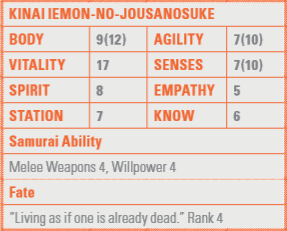
Here's a statblock for one of the retainers of the aforemetioned Shinmeki Iiba-no-tsukasa Masataka.
In addition to retainers, regents also get vassals! I am a little unclear on how these are different from retainers, but they get their own list:
-
Chief Vassals (Koushuu): Direct subordinates of the regent. Close friends and trusted advisors.
-
Clan Vassals (Ichimon): Blood relatives of the regent, who will inherit the domain if the regent dies.
-
Hereditary Vassals (Fudai): Leaders of powerful warrior families. Usually get their own castles at strategic locations.
-
Outsiders (Gaiyou): Vassals whose land was absorbed into the domain. Less loyal than hereditary vassals, and given less power accordingly.
-
Military Vassals (Gun'ekishuu): Part-time vassals conscripted in times of war. Losers, mostly.
-
Intermediary Vassals (Chuugen): Peasants.
-
Small Vassals (Komono): Even worse peasants.
Despite all the things I said, the class system doesn't have as much hold as it used to. Tenra is under miltary control, so a lot of influence comes from your personal strength. If someone calls you a dirty peasant, and you cut them in half with your bare hand, then that's probably a vaid counter-argument.
Capitals
The capital of a domain represents the domain's heart and soul. Each regent tries to make their capital bigger, grander, more elegant, more defensible than their neighbors in a massive international dick-waving contest. To this end, they employ Geomancers, who are practicitioners of a specialized branch of onmyoujutsu dedicated to the MYSTICAL ARTS OF URBAN PLANNING to bring out the latent potential of the city.
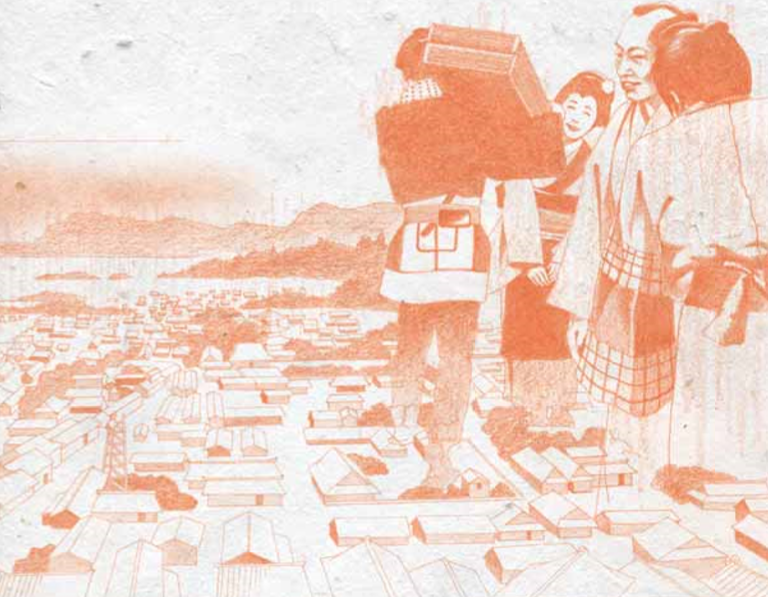
Urban planning wizards are a commonly-accepted phenomenon in Tenra Bansho Zero.
In your typical capital, most of the inhabitants are commoners of various professions, their homes segregated accordingly. As these cities grow, they attract all sorts of legitimate immigrants - and with them come drunken gamblers, lawless drifters, and yakuza. The term "yakuza" here actually just means "someone who doesn't pay taxes and isn't on the official registry", but some of them do set up the sort of crime syndicates more associated with the term in the real world. Despite al these problems, a lot of farmers will give up their farming life to try and make it big in the capital - enough that some lords periodically round up former farmers and ship them back to their farms by force.
The Country
Out in the farmland is about 80% of Tenra's population. A domain's wealth is estimated in produced koku , a measurement of the amount of rice a person eats in one year. More koku, larger supportable popoulation, larger military. Accordingly, farmers are surprisingly high on the social ladder, just below warriors.
Which is not to say that it's fun to be a farmer. Taxes on crops are severe, the work is grueling, and constant trials beset even the most fortunate farms. The farming communities deal with the hardships of the lifestyle with periodic massive festivals of drinking, feasting and carousing.
Farming villages are run by landowners, who rent plots of land out to farmers in exchange for collecting taxes from them and delivering those taxes to the local lord. A successful landlord can potentially also be running a small military force by conscripting his farmers into an army, but this is rare - in the event of a war, the landowners themselves make up most of the lowest ranks of the domain's military force. If a landowner isn't able to fight for their lord, then they have to make up the deficit financially, meaning even steeper taxes.
Every now and then, the peasantry gets fed up with this way of life and revolts. Sometimes several villages will band together and try to rise up against their regent directly, demanding concessions such as reduced taxes. More often than not, this results in even harsher taxes on the offending villages to serve as an example to others.
Travel
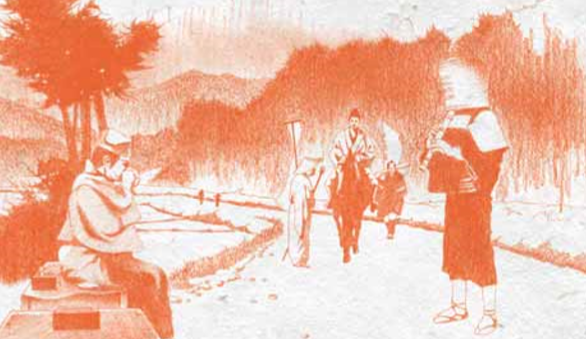
Tenra has a good, healthy road system, which is part of the reason for its strong network of transportation and communication. The major roads connecting major cities are generally pretty safe, but the further you get from the main thoroughfares, the more dangerous it gets. Bandits plague the less-traveled parts of the land, and pirates raid merchant ships in popular sea-lanes.
Wandering drifters are not uncommon in Tenra, but they aren't well regarded, either. Common folk look on them with scorn, and regents tend to see them as dangerous, unpredictable murder-hobos. Being a wanderer can accordingly be difficult, but it also means you don't pay taxes or have obligations to local lords - the trials of the lifestyle are weighed against the freedom it grants.
Major highways connect most of the biggest domains in Tenra, although the Phantom Star resulted in a lot of damage to some of the older ones. Also, between domains there are border checkpoints, where only people with special travel passes can go through. There are standard travel passes given out by local governments, temple passes issued by certain religious sects, and Heaven Passes given out by the Priesthood that allow absolute free movement within Tenra.
Again, though, there are two Priesthoods, so there will always be someone who doesn't think your pass is legitimate.
NEXT: The Karma System.
The Karma System
Original SA post
The Karma System
This time, I'll lead with the comic. It's a bit information-dense!
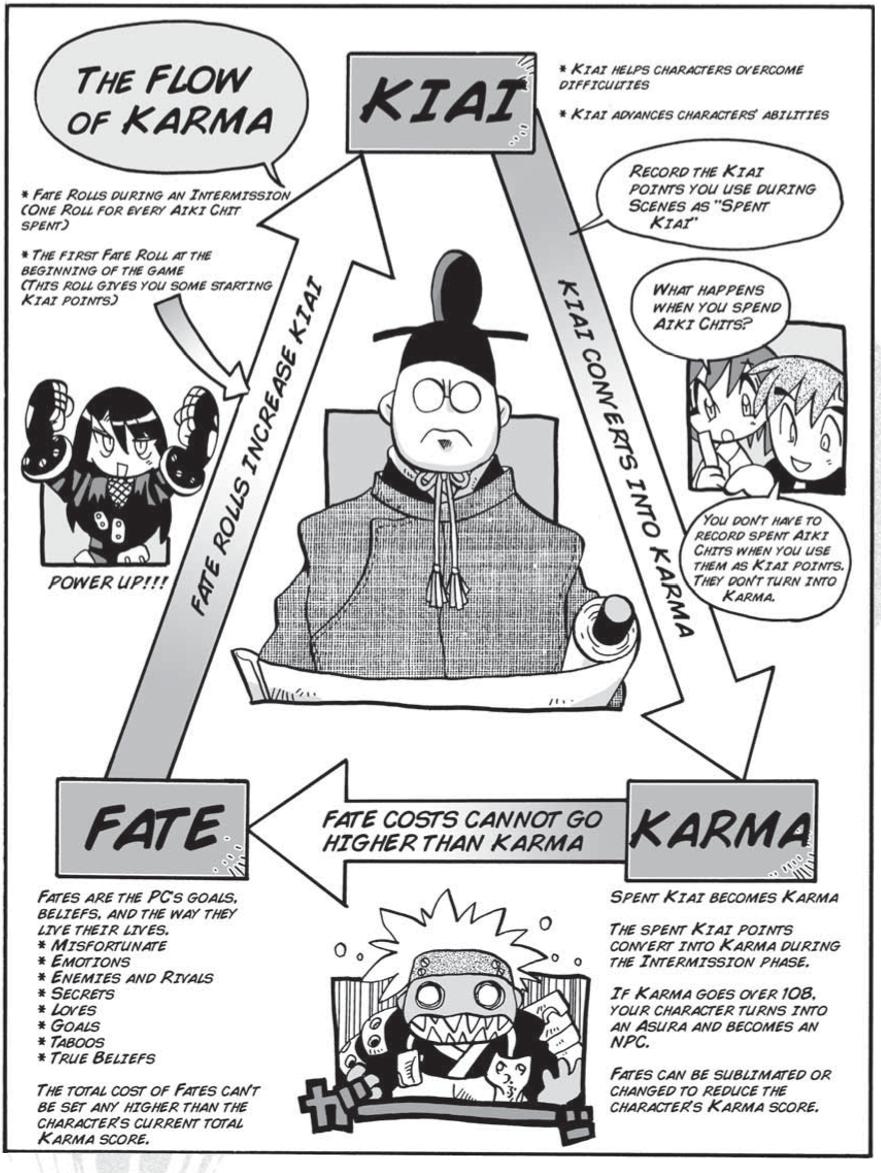
All right, this gets pretty complicated and I'm not crazy about how the book lays it out, so I'm gonna start with Fates and go from there.
Every character has a number of Fates . A new character has one at Rank 2 and one at Rank 3 (Fates work like skills, so they're ranked from 2 to 5). In addition to the two you pick for yourself, the GM picks an extra Fate for each character regarding their Destiny. Fates are the emotional core of who a character is and what drives them - Hatred of the Oni, Loyalty to the Court, Fear of Yourself, and so forth.
Next is Aiki , which the comic barely mentions - odd, since they're integral to the Karma economy. TBZ is based of of kabuki theatre, which has a much more involved audience than western theatre. During moments of high drama, the audience is expected to be calling out to the actors and cheering them on. Aiki represents this dynamic.
Whenever a player plays to their Fates, does something particularly cool or dramatic, or otherwise kicks the game up to the next level, they can be awarded an Aiki chit. There are two ways of handling this - Audience, or Scene Judge. For the Audience method, each player keeps a side reserve of three Aiki chits per scene, and whenever a character does something, any other player can award them Aiki for it (but no more than one Aiki can be earned per action). For the Scene Judge method, the GM picks one player each scene, and they are the sole arbiter of who gets Aiki for that scene.
TBZ is divided into a series of acts, and between each act is an Intermission. During an Intermission, each character can spend any number of Aiki chits to make Fate Rolls, using the Fate of their choice (usually the highest-ranked one) as a skill, and Empathy as the attribute. For each success from a Fate roll, the character gets one Kiai .
Kiai represents the dormant potential within a character. It can be spent to do a shitload of things:
-
You can spend any amount of Kiai to add that many dice to a roll.
-
You can spend three Kiai to increase a skill rank by 1 for the purposes of a single roll. Can be done multiple times on one roll, but can't increase rank past 4.
-
After seeing the result of a roll, you can spend three Kiai each to add successes to the outcome.
-
If another player or NPC is doing something, you can spend two Kiai to interrupt them and act immediately.
-
You can spend any amount of Kiai to take that many extra actions in combat. I don't remember this one but it is arguably less broke than it sounds. Maybe.
-
If an ally takes damage, you can spend one Kiai to intercept the damage and take it yourself.
-
You can spend Kiai to fudge a result on the Emotion Matrix. More on that later.
-
You can spend Kiai to get new equipment.
-
You can spend 10 Kiai to increase an attribute by 1 point.
-
You can spend 5 Kiai to take a new skill at rank 2. Specialist skills can only be picked up during intermissions.
-
You can spend 10/20/40 Kiai to raise a skill by 1 rank. The price increase as the rank increases.
At the start of the game, you get to make one Fate Roll for free. Your starting Kiai is the greater of three and the result. An alternate system suggested is to not roll for Fate ta all - instead, any time you would do a Fate Roll, you instead gain Kiai equal to the rank of your highest Fate.
None of this is without cost, however! Every point of Kiai you spend is added to your Karma . Your initial Karma is determined by the sum of your Archetypes, and it is crucial that you never let your Karma go above 108. If, by the end of a scene, your Karma is over 108, you become an Asura. Asura are lost souls who have been consumed by their fates. No longer trying to change their destiny, they are driven mad in their pursuit of their goals, and are no longer under their player's control. Once you become an Asura, you can never return.
Fortunately, Karma can be reduced! The secret to this lies back at the start of the cycle - with Fates. During an intermission, you can do four things, in this order:
-
Create one new Fate, at a rank of 2.
-
Raise any or all Fates by one rank.
-
Sublimate Fates.
-
Rewrite Fates.
While Fates can be increased at no immediate cost, there is a limit. Each Fate corresponds to an amount of Karma - 0, 10, 30 or 70, depending on the rank from 2 to 5. The total value of your Fates can never exceed your current Karma.
To sublimate a Fate, it must no longer apply to your character - a goal accomplished, a burden discarded. When a Fate is sublimated, your Karma is reduced by an amount equal to the Fate's value. Alternately, a Fate may change - one goal giving way to another, a relationship changing to a new form. In this case, the Fate is rewritten, its rank is reduced by 1, and your Karma is reduced by the difference in value between the old rank and the new one.
In summary:
-
Play dramatically to your Fates to earn Aiki.
-
Spend Aiki during Intermissions to gain Kiai.
-
Spend Kiai to become more powerful, increasing Karma.
-
Sublimate and rewrite Fates to reduce Karma.
-
Spend leftover Aiki to pickup new Fates and continue the cycle.
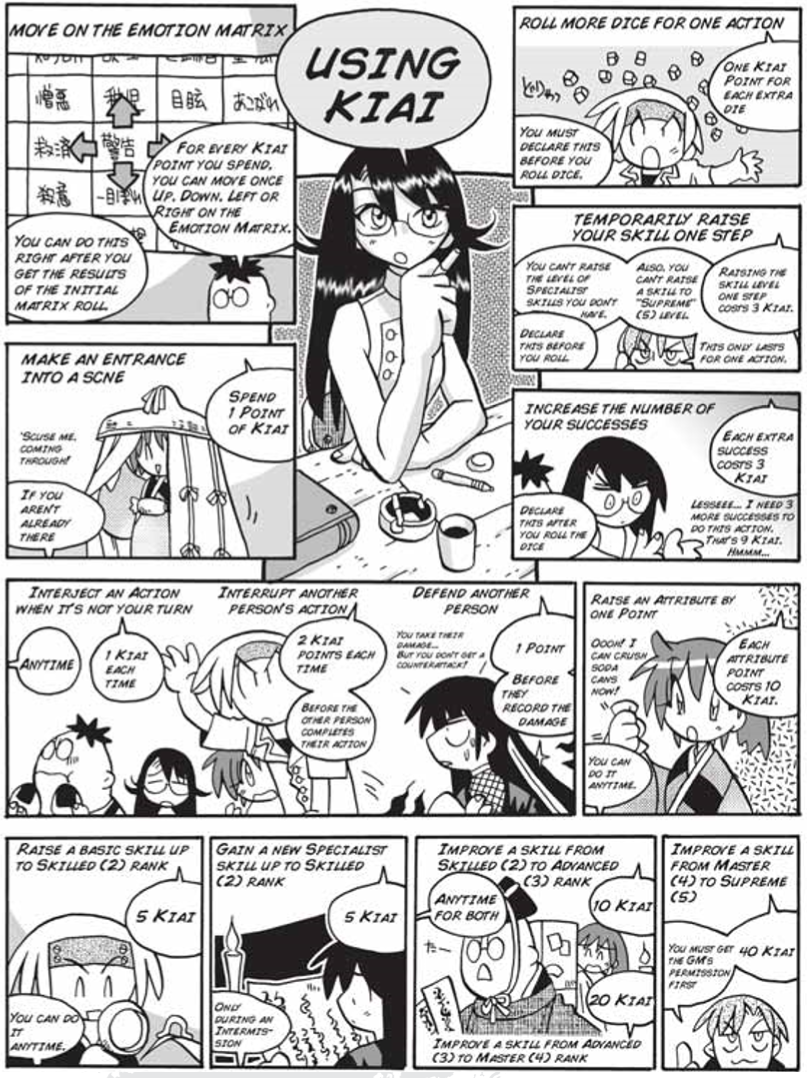
I don't know why this one is kind of blurry.
A couple extra tidbits to the Karma System!
Aiki has a couple other uses I didn't mention. You can spend Aiki directly as Kiai, negating the usual Karma increase. You (or the GM) can give another player an Aiki chit to bring them into a scene they otherwise wouldn't be a part of. They can also be used with the Emotion Matrix, more on that later.
Meikyo Soul Mirror users have a special relationship with Karma - The character and their Meikyo have two separate Karma pools. Kiai used while Interfaced (using it to pilot a mecha) adds Karma to the Meikyo instead of the character, and as the Meikyo accumulates Karma, it becomes more powerful, granting bonuses to Body, Agility and Senses while interfaced. The cap, however, is the same - the combination of the two pools cannot exceed 108. If the combined total passes 108 while you aren't interfaced, you are rejected by the Meikyo, and can never interface with it again. If the total passes 108 while you're interfaced, your soul is trapped in the Meikyo forever, going on a wild rampage as a berserk Armour.
There are two methods of reducing Meikyo Karma. The first is Meikyo Cleansing, a spell available to powerful Buddhist spellcasters. The second is to transfer the Karma to yourself. When you increase a Fate to rank 3, 4 or 5, you can drain 10, 20 or 40 Karma from the mirror, increasing your personal Karma accordingly.
NEXT: War!
War and Tenra
Original SA post
War and Tenra
At this point, it should come as no surprise that Tenra is lousy with wars. Everybody is constantly waging war against their neighbors. Space and resources are limited, and every domain thinks that it should get more of both than the other guy.
War also doesn't look like it used to.
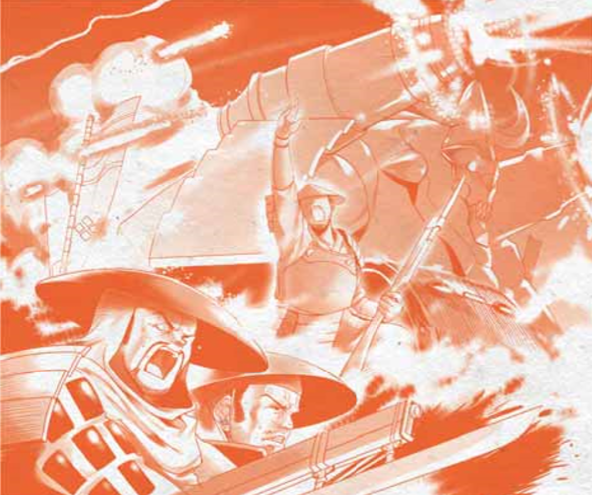
First and foremost among the changes to the face of warfare is the kimenkyo , mass-produced Armours and Kongohki (I haven't talked about them yet, have I? They're fun ) are being deployed to the battlefield en masse for previously unimagined levels of carnage. Infantry, meanwhile, are using new firearms that can decimate entire platoons in seconds. It's like World War I, but with giant robots and cyborgs who could kill you at any moment.
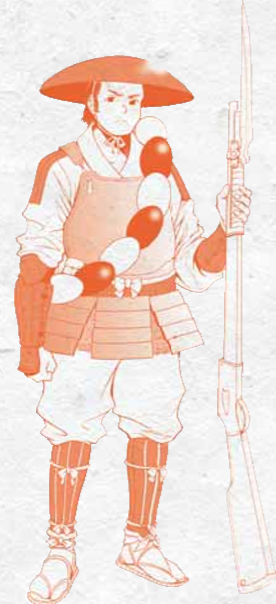
This is an ashigaru , the typical soldier of Tenra's battlefields. The old katana has been replaced with an old gun, using simple gunpowder instead of an of the more ridiculous nonsense wielded by the upper echelons. The ashigaru has a simple statblock given here - 3 in every attribute, 1 in every skill, one gun with damage +5. More on that when I get to combat.
Tenra's battlefield is one caught in the midst of rapid evolution, between the mundane technological advances and the Sufficiently Advanced Technology coming down from the Northern Priesthood. Trench warfare is common, but people are also devising Armours that can roll over or into trenches without so much as stopping. Battles have enormous casualties, and those who survive have their limbs replaced with weapons and are sent back out to kill even more people.
Because battles are so bloody and costly now, alot of emphasis is placed on reconnaissance and pre-engagement strategy - the "quiet" war. Most domains have patrols of specialized Armours on their borders, reacting to threats by sending swift messages back to the capital (via ninja). More powerful lords might have Onmyouji capable of sharing their senses with remote Shikigami for even faster reporting. The intelligence from these advanced scouts can turn a bloody, endless battle into a swift beheading.
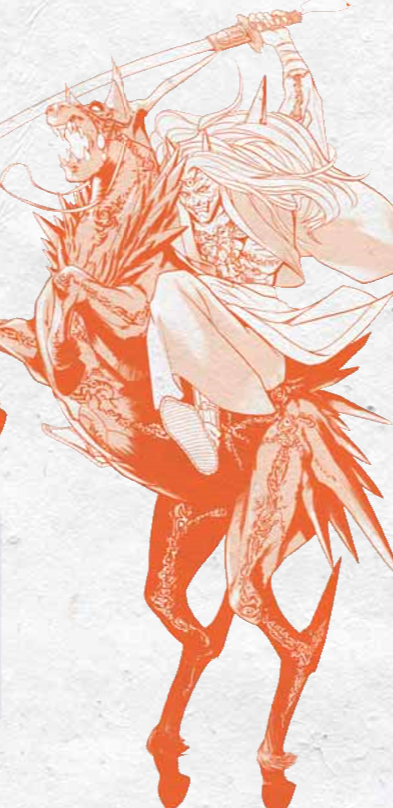
THESE AREN'T YOUR DAD'S HORSES
Cavalry have mostly died out in the modern war. Dudes charging on horses are pretty much no match for a wall of guys with guns. However, they've seen something of a resurgence in the form of Dragon Knights - elite soldiers with rifles, riding on top of soulgem-enhanced super horses. They move in, they shoot everything to shit, they move out.
So, how about those Onmyouji?
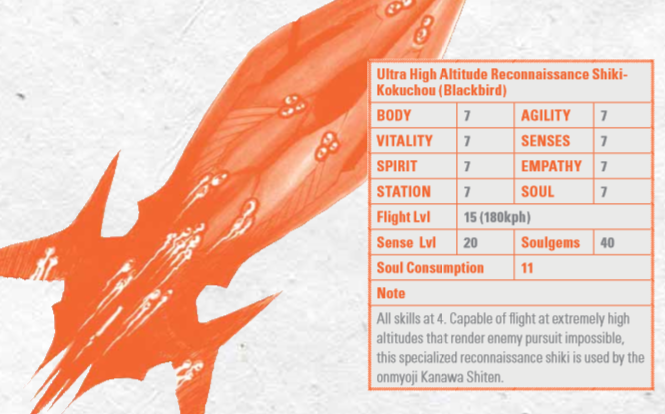
The Taoist spellcasters are physically frail, but that doesn't mean they don't have their own place in this ridiculous hellscape of a battlefield. Their primary place is in the skies - Armours, Samurai and Kongohki can wreak havoc on the ground, but Shikigami can fucking fly.
While Onmyouji are an immensely valuable resource on the battlefield, they're also capricious fuckhead wizards. Most of them are massively individualistic AND not motivated by greed, making it an ordeal to convince them to lend their services to your army.
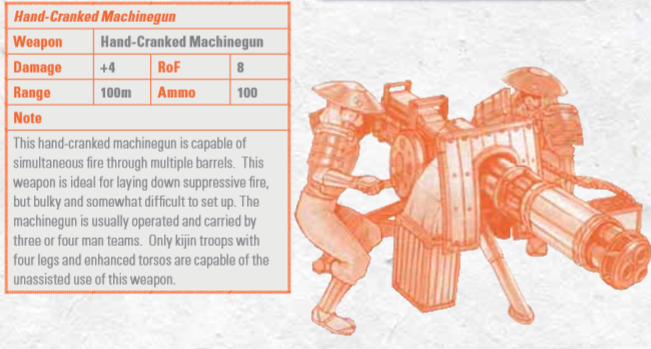
Wars in Tenra are much bigger than the ancient Japanese wars that inspired them. They involve hundreds of thousands of soldiers on average - the largest-scale war in Tenra's history involved a combined total of over 1.6 million warriors. In the past, the Priesthood was often called upon to intervene and mediate to help prevent open warfare, but with the North/South division, that's a really bad idea these days.
In a tradition dating back to ancient times (but changing a bit over the years, battles have a formal, standardized way of beginning. The aggressor's army sends one Armour that fires a noisemaking arrow into the sky as a declaration of intent. The defending army does the same to acknowledge, and the battle begins - first with artillery barrage from a distance, then gradually getting messier and more direct as it escalates.
When the war is over, heroics are rewarded - officers who performed well can expect territory or new titles, conscripts or mercenaries are rewarded in hard cash. Cowards and the incompetent can expect punishments as severe as the rewards for success are grand.
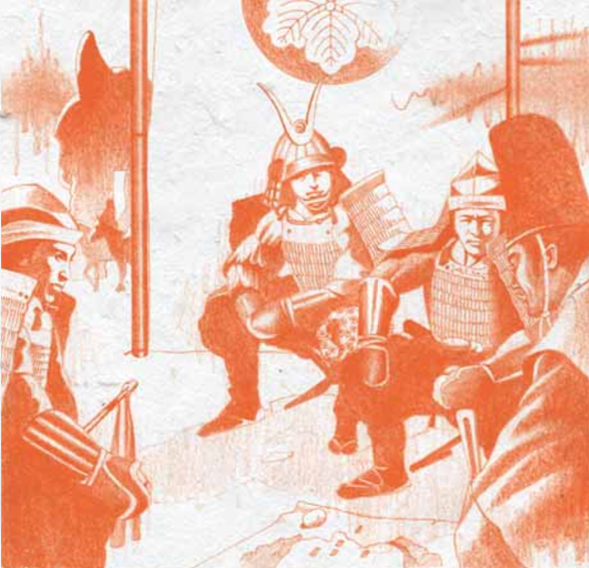
Each army is led by a commander-in-chief, usually a regent, who has command over all the warrior families and armies tha make up the domain's military. However, most soldiers swear loyalty first to their immediate leader, rather than the commander-in-chief, which leads to a lot of divisive paranoia and mistrust between branches. To combat this insubordination, in addition to their generals and tacticians, the commander-in-chief employs military observers who are paid handsomely to keep a close eye on the vassal lords and spot treason before it comes out into the open.
Next: Combat rules!